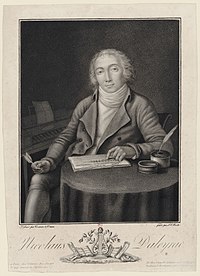Nicolas Dalayrac | |
|---|---|
 Nicolas Dalayrac: lithography[a] | |
| Born | 8 June 1753 |
| Died | 27 November 1809 (aged 56) |
| Occupation | Composer |
| Era | Classical opera |
| Known for | opéras-comiques |
| Works | List of works |
| Awards |
|
| Signature | |
Nicolas-Marie d'Alayrac (French: [nikola mari dalerak]; bapt. 13 June 1753 – 26 November 1809), nicknamed the Musician poet,[1] more commonly Nicolas Dalayrac, was a French composer of the Classical period. Intended for a military career, he made the acquaintance of many musicians in the Parisian salons, which convinced him of his true vocation.
Among his most popular works, Nina, or The Woman Crazed with Love (1786), which tackles the theme of madness and arouses real enthusiasm during its creation, premiered on 23 November at the Stroganov Palace.[2] The Two Little Savoyards (1789), which deals with the rapprochement of social classes, a theme bearing the ideals of the French Revolution, Camille ou le Souterrain (1791), judged as his best production or even Léon ou le Château de Monténéro (1798) who by his leitmotifs announces a new genre. If he forges an international reputation, he remains nevertheless less known in the lyrical field than André Grétry.
His first compositions were violin duos, string trios and quartets. He published them under a pseudonym with Italian consonance. The quartets were very successful, and the true identity of their author was eventually discovered. According to René-Charles Guilbert de Pixérécourt, he was initiated into Freemasonry and was a member of the Masonic lodge of «The Nine Sisters». In 1778 he composed the music for the reception of Voltaire, and of the party in honor of Benjamin Franklin at the home of Anne-Catherine de Ligniville Helvétius. Dalayrac actively participated in the development of copyright.
Cite error: There are <ref group=lower-alpha> tags or {{efn}} templates on this page, but the references will not show without a {{reflist|group=lower-alpha}} template or {{notelist}} template (see the help page).
- ^ Dermoncourt 2012, p. 389.
- ^ Longley 2014, p. 134.